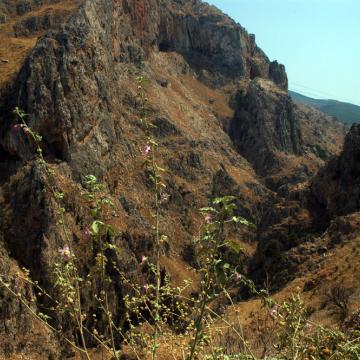GR4340004 - ELOS - TOPOLIA - SASALOS - AGIOS DIKAIOS
Map
Quality
The site includes important bird areas such as Koutroulis mount, areas with endemic plant species (Dikaios mount and gorge), important caves (Agia Sofia) with stenoendemic invertebrates (the spider Pholcus creticus is found only in this cave), as well as gorges, running waters and rare plant formations, such as the chestnut groves and the Arbutus unedo maquis.Birds of prey and vultures as Aquila chrysaetos, Gyps fylvus and Gypaetus barbatus breed on Koutroulis mount, while Falco peregrinus, Pernis apivorus and Falco eleonorae live in or pass through the site. The endemic species Centaurea argentea and Centaurea redempta, a rare pant (IUCN 1993) are both protected by the Greek Law (Presidential Decree 67/81) are found on Dikaios mount and at Topolia area. Lathyrus neurolobus, Carex cretica and Campanula cretica (included in section 3.3. by its synonym Symphyandra cretica) are rare endemic species (IUCN, 1993), also protected by the Greek Law (Presidential Decree 67/81), and occur on Elos area. Many greek or cretan endemic plants (listed on 3.3.) are also found on mountain Dikaios and at Topolia gorge (chasmophytic flora). Brassica cretica ssp. cretica is a chasmophyte found only in C. & S. Lebanon out of Greece.The site is also rich in cretan endemic snails (listed on section 3.3), many of them occurring only in westen Crete.Reptile species (listed on section 3.3.) protected by the Greek Law (Presidential Decree 67/81) and by the Bern convention (Annex II & III), as well as bats and the shrew Suncus etruscus, also legally protected and (Greek Law and Bern Convention) and listed on the Red Data Book of Greece, are constant residents, populating many of the smaller caves at Topolia. Finally, Rhinolophus ferrumequinum ssp. creticum, included in section 3.2.c. as Rhinolophus ferrum-equinum, is a subspecies endemic to Crete.The Elos and Pervolia areas are also ecologically important for the rare in southern Greece formations of sweet chestnut groves and woods (Castanea sativa). Arbutus unedo maquis, also rare in southern Greece and Crete, occur in the site.
Other characteristics
The site (West Crete), is a mountainous area, begining at Topolia on the north, and ending just below the top of Dikaios mount (1008 m) on the south and it is delimited by Koutroulis mount (1071 m) and by the peak of Psilo Kefali mount (901 m) on the western side, while Sassalos & Milonou settlements are the east side borders. This area includes Topolia gorge, with Tiflos river, originating at Dikaios mt. and streamig down through the gorge); the north side and the summit of Dikaios mount, the east side and the summit of Koutroulis mount and the lower mountains of Psilo Kefali, Oxo Koproula (695 m), Vitsilangos (683 m) and Sellakia (573 m). The well known cave of Agia Sofia is also in the area.The mountainous vegetation is mainly phryganic, dominated by the shrubby perennials Sarcopoterium spinosum, Coridothymus capitatus, Calicotome villosa and Cistus creticus. There are also shrub and tree formations of Pistacia lentiscus and Ceratonia siliqua. Chestnut groves (Castanea sativa), one of the rare chestnut formations in Crete, are situated between Elos and Pervolia settlements. Maquis formations with Arbutus unedo and Erica manipuliflora are commom on non-limestone substrate.Olea europea groves occupy a considerable part of the site.
Documentation
1) CORINE Information System. European Environment Agency. CORINE, Biotopes, 1991.
2) Ekonomidou E., 1988. Entopismos kai meleti ton ygroviotopon kai allon simantikon gia tin ornithopanida viotopon tis Kritis (Location and study of wetlands and of other important for Avifauna biotopes of Crete). Final Report. Volume 1. Patras University - Ministry of Environment, Physical Planning and Public Works.T
3) Grimmet R.F.A. & Jones, (Compilers) 1989 : Important Bird Areas in Europe (ICBP), Technical publication no 9.
4) Hellenic Ornithological Society, 1994 : Simantikes Periohes gia ta Poulia tis Elladas
5) Karandeinos, M. (ed.). 1992. To Kokkino Vivlio ton apeiloumenon spondylozoon tis Elladas (The Red Data Book of threatened vertebrates of Greece). Hellen. Zool. Soc. & Hellen. Orn. Soc. p. 373.
6) Kypriotakis, Z. : unpublished data.
7) Legakis A. (Editor), 1995 : Apeiloumena, Prostateyomena kai Endimika eidi Zoon tis Eladas. Zoologiko Mouseio, Tm. Viologias, Pan. Athinon.
8) Martens, J. 1967 : Plecotus austriacus (Fischer) auf Kreta mit Bermerkumgen zu weiteren Arten (Mammalia, Chiroptera). Bonn.zool.Beitr. 18(3-4) : 253-362
9) Pieper H., 1976 : Zur Verbreitung einiger Kleinsaeuger auf Kreta. Z.Saeugetierk. 41 : 274-277.
10) Pieper H., 1977 : Fledermaeuse aus Schleiereulen-Gewoellen von der Insel Kreta. Z.Saeugetierk. 42(1) : 7-12.
11) Senglet, A. 1971 : Notes sur les Pholcidae (Arachn.) de Grece. Mitt.schweiz.ent.Ges. 44(3-4) : 345-359.
12) Turland N.J., Chilton L. & Press J.R., 1993 : Flora of the Cretan area. The Natural History Museum, London : HMSO.
13) Valakos, E. Unpublished data.
14) Vardinoyannis K., 1994. Biogeografia ton cherseon malakion sto notio nisiotiko aigaiako toxo (Biogeography of land snails in the south Aegean arc). Ph.D. Thesis. Univerity of Athens.
15) Wettstein O. 1953 : Herpetologia aegaea. Sber.oest. Akad. Wiss. math.- naturw. Kl.Ab. I 162(9-10) : 651-833.
16) Georghiou K. 1995. Checklist of Endemic, Rare and Threatened Plants of Greece. Draft. University of Athens. (3.3, 3.4, 4.2)
17) Natural History Museum of Crete, Conservation of Gypaetus barbatus in Asfendou-Kallikratis (under evaluation)
Reference: Natura 2000 data form, database release 7 Feb 2014




